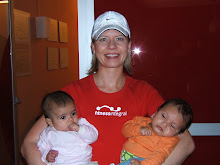When can I start doing crunches?

Then I ask: Why do you want to do crunches? What is it that you want to accomplish?
Generally the response is "I want back my pre-pregnancy figure ."
Ok. There are multiple issues here.
First, we have got to put to rest the spot reduction myth. For once and for all, crunches will NOT reduce your waist size. Actually, crunches can increase your waist size, whether via gaining muscle (not the usual reason) or more likely from pushing the abdominal wall outwards during crunches. And to reiterate, even perfectly done crunches will NOT reduce waist size or decrease body fat.
Second, to have a flat belly you need two things: low body fat and a strong transversus abdominus (TA) muscle. Crunches do not lower body fat nor do they work the TA.
Thirdly, crunches are not necessary for most people. Other core exercises are much more important.
Fourthy, for postpartum moms, crunches are dangerous. They can worsen a diastasis recti (separation of the rectus abdominus at linea alba) and they increase intra-abdominal pressure which should be avoided until the pelvic floor is reconditioned.
So, stay away from crunches. They have a very poor risk to benefit ratio.


